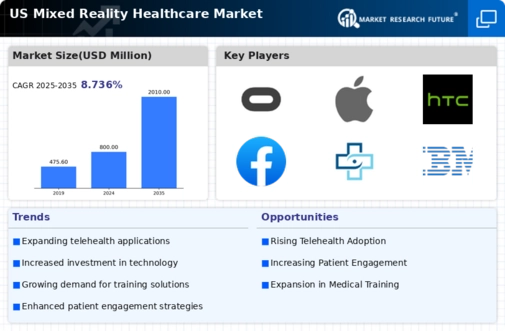Rising Focus on Personalized Medicine
The shift towards personalized medicine is influencing the mixed reality-healthcare market. As healthcare providers aim to tailor treatments to individual patient needs, mixed reality technologies offer tools for enhanced visualization and simulation of treatment options. This approach not only improves patient understanding but also aids in decision-making processes. The market for personalized medicine is anticipated to grow by 30% in the coming years, which may lead to increased integration of mixed reality solutions in clinical settings. Consequently, the mixed reality-healthcare market is likely to expand as healthcare professionals adopt these technologies to deliver more customized care.
Technological Advancements in Imaging
The mixed reality-healthcare market is experiencing a surge in technological advancements, particularly in imaging technologies. Innovations such as augmented reality (AR) and virtual reality (VR) are enhancing diagnostic capabilities and surgical precision. For instance, the integration of AR in imaging allows surgeons to visualize complex anatomical structures in real-time, potentially reducing surgical errors. The market for AR in healthcare is projected to reach approximately $1.5 billion by 2026, indicating a robust growth trajectory. These advancements not only improve patient outcomes but also streamline surgical procedures, thereby driving demand within the mixed reality-healthcare market.
Growing Demand for Remote Patient Monitoring
The demand for remote patient monitoring is reshaping the mixed reality-healthcare market. As healthcare providers seek to enhance patient care while minimizing costs, mixed reality solutions offer innovative ways to monitor patients remotely. Technologies such as AR can facilitate virtual consultations and real-time health monitoring, which are increasingly preferred by patients. In 2025, the remote patient monitoring market is projected to grow by 25%, indicating a shift towards more accessible healthcare solutions. This trend is likely to propel the adoption of mixed reality technologies, as they provide effective tools for remote engagement and monitoring.
Increased Investment in Healthcare Technology
Investment in healthcare technology is a significant driver for the mixed reality-healthcare market. Venture capital funding and government grants are increasingly directed towards innovative healthcare solutions, including mixed reality applications. In 2025, investments in healthcare technology are expected to exceed $200 billion, with a notable portion allocated to mixed reality solutions. This influx of capital fosters research and development, enabling the creation of advanced mixed reality tools that enhance training, patient care, and operational efficiency. As a result, the mixed reality-healthcare market is likely to expand, driven by these financial commitments.
Regulatory Support for Innovative Technologies
Regulatory support plays a crucial role in the growth of the mixed reality-healthcare market. Government agencies are increasingly recognizing the potential of mixed reality technologies to improve healthcare delivery. Initiatives aimed at streamlining the approval process for innovative medical devices and software are being implemented. For example, the FDA has established guidelines that facilitate the rapid assessment of AR and VR applications in healthcare. This supportive regulatory environment encourages companies to invest in mixed reality solutions, thereby driving market growth. As regulations evolve, the mixed reality-healthcare market is expected to benefit from increased innovation and adoption.
























Leave a Comment